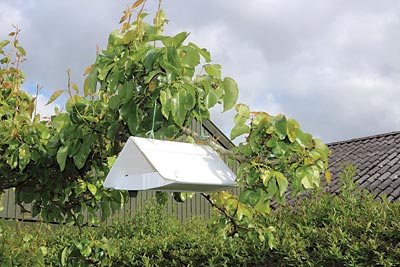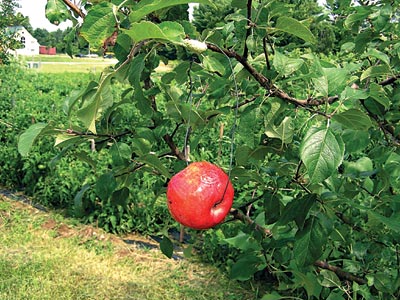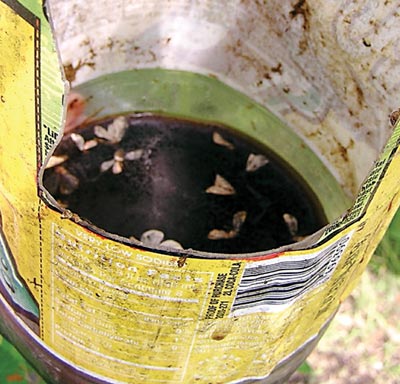 |
| Pheromone trap for codling moth. Photo by Slaunger at https://commons.wikimedia.org/wiki/File:Cydia_pomonella_trap_hanging_in_tree_2012-06.jpg used via Creative Commons Attribution-Share Alike 3.0 Unported license. |
 |
| A red ball trap made from a store-bought apple, used to trap apple maggot flies. English photo |
 |
| A soda bottle holding cider and molasses traps codling moths. English photo |
By C.J. Walke
In my March-May 2016 MOF&G article, I wrote about orchard pest thresholds and the use of traps and trapping methods to capture and monitor pest populations to know whether pressures are reaching limits that will significantly decrease fruit quality or yield. Even in small plantings, traps can provide helpful information about pests in your orchard ecosystem. Traps are also useful in young plantings that have yet to fruit or are in their first years of fruit bearing but have not yet reached marketable yields. Collecting and retaining this information will highlight trends in your orchard system and help establish methods of pest control before populations escalate.
Store-bought Traps
Many sources offer pest traps (a couple are listed at the end of this article), but your decision on which to use will be based upon pricing relative to the quantity of certain traps; upon availability – supplies may run short during the flowering and fruiting seasons; and upon location – whether you prefer to purchase online or to visit a physical store. Pricing and quantity can affect decisions, since buying in bulk will typically save money – but depending on your orchard scale, you may need to purchase multiple years’ worth of traps to realize savings, or some products may not be available in the smaller quantities you desire. Availability is also key, because if you wait until the growing season, some supplies may have run out.
White sticky cards can be used to trap European apple sawfly. The white of the card mimics the white of the apple blossom, which attracts these pests. When they land, they become stuck. These cards should be hung before bloom (a little late for this article) at eye level on the south side of the tree where the sunlight is strong and the trap is highly visible.
Yellow sticky cards can be used to trap apple maggot fly (more details on this pest below). The adhesive on these cards contains a food attractant that makes the trap more inviting. This attractant is not found in Tangle-Trap (also mentioned below).
Red ball traps are used in a similar fashion to trap apple maggot flies in midseason and should be hung in trees by July 1 and monitored twice per week. These traps do not come with the sticky substance applied, so you need to purchase Tangle-Trap (also called Tanglefoot) to coat the spheres. One ounce of Tangle-Trap should cover three traps. These plastic traps come in reusable and disposable models. The former must be cleaned of flies and coated with new sticky material at least once per season. Disposable models cost less but seem wasteful. Trapping can be enhanced in larger plantings by hanging an apple essence lure near the traps, but this does not seem necessary in smaller plantings. Recommendations are one to two traps per dwarf tree, two to four per semi-standard and four to eight per standard.
Pheromone wing traps work well for monitoring codling moth activity in your orchard when used with a codling moth lure. The lure – the pheromone essence of a female codling moth – attracts males into the trap. When they land, they stick to the bottom of the trap, similar to what happens with the white sticky cards mentioned previously. The white sticky bottoms of the pheromone wing traps can be replaced if the trap fills with moths, since we see a couple of generations of this pest each year, but the lure must be replaced midseason, as the pheromone essence runs out. These traps should be hung before bloom, at eye level in the tree for easy inspection. Only one or two are needed per acre.
Homemade Traps
Most of the traps mentioned above can be replicated in a homemade model for less cost, but with a little time and effort. You most likely won’t be able to make your own pheromone essence or Tangle-Trap; those would still need to be purchased. I have heard from people who used other types of sticky materials (pine tar and grease), but these have strong odors that may ward off pests. I have talked with some people who make their own white sticky cards from white paperboard or painted cardboard scraps, but these do not hold up well in wet weather and need to be replaced frequently.
You can make your own codling moth traps with empty half-gallon milk jugs or 2-liter soda bottles, apple cider vinegar and molasses. In an empty gallon jug, place 2 cups of apple cider vinegar and 1/2 cup of molasses, then fill with water and mix. Cut a hole in the side of the soda bottle so that you can pour in the mixture and moths can enter. Pour in a couple of inches of the mix. Hang the bottle upright in the tree, tied by the top. Codling moths will be attracted to the odors. Hang these traps from early May through September in easily managed locations so that you can remove moths and refill the sweet mixture.
Red ball traps can be replicated in a few ways. Painted plywood scraps can be cut into 6-inch x 6-inch squares and painted on both sides – yellow with a red apple-sized circle in the center. Coat the red circle with sticky material. The yellow color seems to make the red more visible to apple maggot flies. These flat boards are much easier to clean than the ball traps. I recommend still using the apple essence lure.
Real apples can be used as well. Coat them with sticky material and hang them from the tree with a scrap of wire, then compost them instead of cleaning. Some people say this is the true use for a store-bought Red Delicious! When coating, leave the top and bottom of the apple clear so that odors don’t get trapped by the sticky material. Run a scrap of wire up through the center of the apple and hang the fruit from the tree.
The first time I tried using real apples, I bought a 3-pound bag of conventional Red Delicious and used them all in the orchard, in addition to red ball traps. After a couple of weeks, I noticed that the real apples had only a couple of apple maggot flies on them, but the red ball traps were covered, even where I wasn’t using an apple essence lure. I had heard of many people using this method with success, so I wondered what I had done wrong.
After a little research and talking with a couple of experts with far more experience than I, we determined that the conventional apples were most likely sprayed with a “synthetic produce quality enhancer” after harvest to slow ripening in storage. That product was most likely still present when I hung the apples as traps. So I removed all of those apples, bought a bag of organic apples, hung them as traps, and they were covered in just a few days. (For more on synthetic produce quality enhancers, which are not allowed by the USDA National Organic Program, research SmartFresh Technology.)
Resources
Organic Growers Supply https://fedcoseeds.com/ogs/
Great Lakes IPM https://www.greatlakesipm.com/
Evergreen Growers Supply https://www.evergreengrowers.com/
C. J. Walke is MOFGA’s organic orchardist. You can address your orcharding questions to him at 568-4142 or [email protected].

